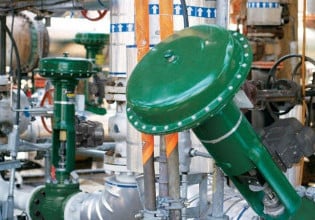Industrial Common Mode Chokes Released to IATF Automotive Supply Chain Standards
Pulse Electronics is releasing IATF-compliant variants of its self leaded inter connection and Shasta industrial common mode chokes for use in automotive applications.
In response to the demand for higher power components in electric vehicles (EVs), hybrid electric vehicles (HEVs), and other vehicles, Pulse Electronics is releasing IATF versions of its industrial SLIC (self leaded interconnection) and Shasta Common Mode Chokes (CMC).

IATF versions of Pulse SLIC/Shasta common mode chokes. Image used courtesy of Pulse Electronics
The IATF program (IATF 16949:2016), the international standard for automotive quality management systems, dictates process and quality controls to reduce defects, variation, and waste in automotive supply chains.
In addition to IATF, the products are AEC-Q200 compliant based on the prior qualification of the industrial variants.
The IATF CMC models are available with inductance ranges from 92 µH to 1.8 mH, supporting currents from 2.8 A to 20 A in a variety of surface mount (SMT) package sizes.
The parts have a dielectric strength of 1500 VRMS and will be an option for automotive system designers looking for power line CMC solutions for emerging EV, HEV, and other automotive applications.
SLIC/Shasta CMCs are designed for peak impedance at low MHz frequencies.

Common mode choke (PA2752NL) impedance plot. Image used courtesy of Pulse Electronics
Common Mode Chokes
Common mode chokes act as filters that help suppress high-frequency, common mode interfering signals (like electromagnetic interference) in power supplies, signals, or audio lines.
CMCs are similar in construction to a transformer with separate windings around a single magnetic core. However, while a transformer is designed to condition signal levels and provide isolation, a choke is designed to reject unwanted signals.
A transformer receives input signals on a primary winding isolated from and magnetically coupled to a separate secondary winding. For a choke, signals are passed in parallel through both windings wound across a magnetic core. In this configuration, the choke acts as a well-matched, dual-channel inductor.
The inductive properties of a choke are excellent for rejecting high-frequency EMI signals as their impedance values increase with frequency, “choking” unwanted interferers.
The matching of the inductive properties of the choke is critical as any impedance mismatch could result in common mode to differential conversion, allowing unwanted interfering signals to pass.

Common mode choke. Image used courtesy of Pulse Electronics
EV Onboard Charger Application
Traditionally designed for industrial applications, the automotive-qualified SLIC/Shasta CMCs could be useful in a range of EV and HEV applications where higher voltage and power levels are becoming more prevalent. Potential applications include onboard charging (OBC), battery management systems (BMSes), and traction inverters.
For EV OBCs, CMCs can suppress EMI signals at the charging interface with the lithium-ion battery pack. CMCs can also be useful for EMI filtering in the PFC circuitry associated with the OBC input rectification.

CM chokes in an EV onboard charger application. Image used courtesy of Pulse Electronics
Automotive Ethernet PHY Applications
Modern automobiles have many systems like ADAS (lidar, radar, camera, etc.), infotainment, diagnostics, and vehicle control (brake-by-wire) that rely on internal ethernet communications. These ethernet systems communicate key data, in digital form, through the vehicle via cable pairs. An ethernet physical layer transceiver (PHY) interfaces with MCUs to transmit and receive vehicle data across the ethernet networks.
Because of the challenging operating environment, and the use of untwisted cable pairs, these automotive ethernet applications typically require higher levels of noise suppression.
In automotive applications, a CM choke can be placed between the PHY transceiver and the transmission cable connector to help block common mode noise in both directions.
Series AC coupling capacitors on the signal lines will reject DC-interfering signals since inductive CMCs do not block DC.

Automotive ethernet systems are vital to vehicle operation. Image used courtesy of Pulse Electronics

CM chokes suppress noise in automotive ethernet systems. Image used courtesy of Pulse Electronics






